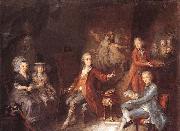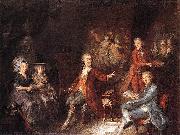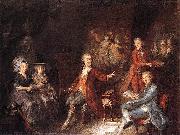|
Alma Tadema.org, welcome & enjoy!

|
|
Here are all the paintings of Martin Johann Schmidt 01
| ID |
Painting |
Oil Pantings, Sorted from A to Z |
Painting Description |
| 52553 |
 |
St Elisabeth Distributing Alms |
c. 1778
Oil on canvas, 64 x 192 cm
|
| 43911 |
 |
The Painter and his Family |
1790
Oil on canvas,
on paper board,
48 x 64,2 cm |
| 85845 |
 |
The Painter and his Family |
Date 1790(1790)
Medium Oil on canvas, on paper board
Dimensions Height: 48 cm (18.9 in). Width: 64 cm (25.2 in).
cjr |
| 90027 |
 |
The Painter and his Family |
1790(1790)
Medium Oil on canvas, on paper board
cyf |
|
|
| Martin Johann Schmidt
|
| Austrian Painter, 1718-1801,was one of the most outstanding Austrian painters of the late Baroque/Rococo along with Franz Anton Maulbertsch. A son of the sculptor Johannes Schmidt and a pupil of Gottlieb Starmayr, he spent most of his life at Stein, where he mostly worked in the numerous churches and monasteries of his Lower Austrian homeland. While the evolution of his style after 1750 shows that he had either spent a formative period in northern Italy or had at least had extensive contact with northern Italian works of art prior to that date, his works are also clearly influenced by Rembrandt (visible above all in his etchings) and the great fresco-painters of the Austrian Baroque, Paul Troger and Daniel Gran. Despite not having received formal academic training, in 1768 he was made a member of the imperial academy at Vienna due to his artistic merits, which by that time had already been recognized by a wider public inside and outside of Austria. Primarily he painted devotional images for private devotion and churches, including a considerable number of large altar paintings. His lively and colourful style made him extremely popular with people from all levels of society already during his lifetime. From 1780 mythological and low-life themes became increasingly frequent, only to be replaced by a renewed concentration on religious topics during the very last years of Schmidt's life. He was at that an important draughtsman and has left numerous etchings which clearly show Rembrandt's influence. While his earlier works typically show a warm chiaroscuro, from about 1770 he used increasingly stronger and more lively colours. Simultanueously, both his style and his brush technique became much more free, making him, like Franz Anton Maulbertsch, an important predecessor of impressionism. In this aspect, his mature style is completely contrary to neoclassicism, the style which increasingly dominated European art after about 1780.
|
|
 All the Alma Tadema's Oil Paintings
All the Alma Tadema's Oil Paintings

Supported by oil paintings and picture frames

Copyright Reserved
|


